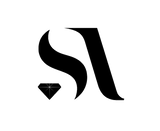The most common diamond shape is the round cut diamond, representing around 75 percent of all diamonds sold. Thanks to the dynamics of its shape, including its optimal reflection of light, the round diamond is more popular than fancy diamond shapes. For many looking into a classic to spoil their loved ones, a Round Cut Diamond Ring is a solid choice.

What is a Round Cut Diamond?
The round diamond is a cut consisting of 58 facets, of which 33 can be found on the diamond's crown and the other 25 on the pavilion. The stone has a cone shape that funnels light up to the top enhancing the reflection of light from the diamond and beautifully causing the diamond to sparkle.
The structure of the cut helps to make the diamond one of the brightest of all the cuts and a popular option for engagement rings. In addition, the shape's simplicity complements the stone, keeping the emphasis on the diamond's sparkle and quality itself.
History of the Round Cut Diamond
The popularity of the round cut traces back over a century. In 1919, in his research publishing, "Diamond Design: A Study of the Reflection and Refraction of Light in Diamond," Marcel Tolkowsky’s remarks triggered a surge of interest in the Round Diamond. Couples getting engaged started showing their love with the round cut and it's been popular ever since. Even now, the Round Cut Diamond remains the most common cut of diamonds since Tolkowsky's influence.
The Old European cut was a popular choice previously during the Victorian, Edwardian, and Art Deco eras. As knowledge and technology progressed over time, the techniques for cutting diamonds became more refined and cutting styles progressed towards larger tables, smaller culets, and wider, leaner facets. The Round cut is preferred for its brilliance while Old Europeans were cut primarily for color. The biggest difference between the Old European and the Round Cut is that the Old European retains facets with triangular blocks while the Round Brilliant has thinner faces.

Cut of Diamond
When it comes to grading a round diamond, the cut is possibly the most significant aspect. After all, it is the beauty of a diamond that makes it so unique and impacts the consistency of its light output on the cut. Note that the diamond shape and diamond cut are two separate things. The cut refers to the faceting proportion and technical aspects while the shape refers to the stone's geometrical shape.
GIA has developed a grading system that allows laboratories to offer a cut grade to round diamonds, with scores including Excellent, Very Good, Good, Fair to Poor. The higher the quality of cut, the more costly the stone. Currently GIA gives cut grades only to round diamonds.
Although the cut grade is important, the stone’s interactions with light is more critical. When searching for individual diamonds, it is important to check the diamond's HD videos and pictures, and see how it interacts with light. Due to low light output, you don't want to see windowing or extinction on your stone.

Clarity of Round Cut Diamond
Choosing your round diamond's grade of clearness depends on your preference. Almost all diamonds have inclusions, including those marked as flawless. What distinguishes a diamond as flawless is that the inclusions are minuscule and cannot be seen by the naked eye.
The higher the grade of clarity, the costlier the diamond is. Provided that you are already paying a premium for choosing a circular diamond, you can pick a lower grade of clarity without losing quality. Most inclusions, except for the Slightly Included and Included Grades, can not be seen by the naked eye.
Price of Round Cut Diamond
Round Cut diamonds are, and for good cause, the most costly types of diamonds.
Firstly, a substantial part of the rough stone must be extracted while cutting round diamonds. Usually, at the completion of the cut and polish process, about 40 percent of the original stone remains. Princess cut diamonds use about 80 percent of the original weight of the stone as a comparison. A round cut's lower yield means a higher price because of the lost potential of the uncut stone.
The popularity of these diamonds also boosts the price. About 60 percent of all engagement rings are made with a circular diamond cut. Because of the high demand of this product, it simply costs more to obtain round cut stones. This holds true when also considering the round cut diamond's unmatched elegance and beauty. Its classic appeal and flexible shape make it an elegant choice.
Although a round cut diamond is costly, the advantages, we believe, justify the price.
Conclusion
Round cut diamonds hold a lot of history in them and are with reason the most popular cut of diamonds in the market. Using this buying guide you should be able to find a beautiful diamond which will give you the most brilliance out of your money.

